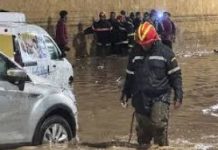While Pakistan and India are caught up in the rising tensions at the Line of Control (LoC), Kashmiris across India are facing rising violence following last week’s deadly attack that killed 26 tourists in Pahalgam in the Indian Illegally Occupied Jammu and Kashmir (IIOJK).
According to the BBC, Shabir Ahmad Dar, a man from IIOJK who had been selling intricate pashmina shawls in the hill town of Mussoorie for two decades, was seen being publicly assaulted and harassed along with a fellow Kashmiri salesman in a video that circulating social media.
In the video, the attackers, who were members of a Hindu right-wing group, thrashed and hurled abuses at Shabir and his friend as they ransacked their stall, located on a busy boulevard.
“They blamed us for the attack, told us to leave town and never show our faces again,” said Shabir.
His goods, worth thousands of dollars, remain abandoned at the stall. “But we are too scared to go back,” he admitted.
While police arrested three individuals later in response to the outcry over the assault, their subsequent release on bail after paying a fine and issuing an apology to the victims has done little to assuage the fear gripping the Kashmiri community in Mussoorie.
But Dar had already left by then, along with dozens of other Kashmiri shawl sellers, who, after living in Mussoorie for decades, say they no longer feel safe there.
The Pahalgam attack has unleashed a wave of hostility towards Kashmiris residing in various Indian cities.
Over a dozen reports have emerged detailing harassment, vilification, and threats faced by Kashmiri vendors and students at the hands of right-wing groups, and even from their own classmates, customers, and neighbours, the BBC reported.
Harrowing videos circulating online show Kashmiri students being chased off campuses and assaulted in the streets.
In an appeal for peace, a survivor of the Pahalgam attack, whose naval officer husband was killed, urged people not to target Muslims and Kashmiris. “We want peace and only peace,” she pleaded.
Despite these calls for calm, fear has forced many Kashmiris like Shabir to return to their homeland.
Ummat Shabir, a nursing student at a university in Punjab, recounted how women in her neighbourhood labelled her a “terrorist who should be thrown out”.
“The same day, my classmate was forced out of a taxi by her driver after he found out she was a Kashmiri,” she said. “It took us three days to travel back to Kashmir but we had no option. We had to go.”
However, for many who have returned, even home does not feel safe anymore.
As the investigation into the Pahalgam attack continues, security forces in IIOJK have detained thousands of people, closed over 50 tourist destinations, deployed additional army and paramilitary troops, and demolished several homes belonging to families of suspected attackers accused of “terrorist affiliations”.
The crackdown has sparked fear and unease among civilians, many of whom have called the actions a form of “collective punishment” against them.
While IIOJK Chief Minister Omar Abdullah emphasised the need to punish the guilty, he cautioned against letting “innocent people become collateral damage”.
Former chief minister Mehbooba Mufti also criticised the demolitions, urging the government to differentiate between “terrorists and civilians”.
“Whenever tensions escalate, we are the first ones to bear the brunt of it. But we are still treated as suspects and expected to put our lives on hold,” another student, who wanted to remain anonymous, told the BBC.
Shafi Subhan, another shawl seller from Kupwara district who also worked in Mussoorie for two decades, noted that the current backlash feels significantly worse than in the past.
He stated that he had never faced public threats before, not even after the 2019 Pulwama attack, which killed 40 paramilitary police troopers.
To him, Mussoorie felt like home, a place where he found peace – despite being hundreds of kilometres away. He said he shared an emotional bond with his customers, who came from all parts of the country
“People were always kind to us, they wore our garments with so much joy,” Subhan recalled. “But on that day when our colleagues were attacked, no one came to help. The public just stood and watched. It hurt them physically – but emotionally, a lot more.”
Peace has long been fragile in the region and has left civilians caught in a precarious situation.
While officials point to recent improvements in infrastructure, tourism, and investment as signs of stability since the revocation of the region’s special constitutional status in 2019, critics argue that this calm has come at the expense of civil liberties and political freedoms.
“The needle of suspicion is always on locals, even as militancy has declined in the last one-and-a-half decades,” says Anuradha Bhasin, the managing editor of the Kashmir Times newspapers. “They always have to prove their innocence.”
Following the recent attack, Kashmiris held candlelight vigils and protest marches, with a complete shutdown observed a day after the killings and newspapers printing black front pages.
Omar publicly apologised, acknowledging his “failure” to protect visitors.
Bhasin noted that Kashmiri condemnation of such attacks is not new, emphasising that, “no one there condones civilian killings – they know the pain of losing loved ones too well.”
“This would just instil more fear and further alienate people, many of whom already feel isolated from the rest of the country,” she said.

















